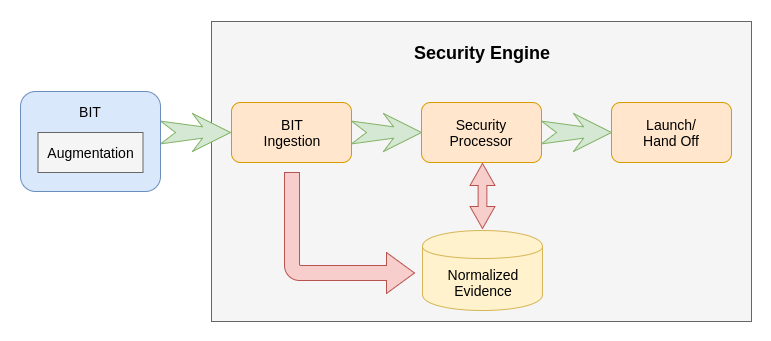General Architecture¶
The general execution flow for TrenchBoot is broken into three phases, Bootstrap, Intermediate, and Runtime. The Bootstrap phase primarily consists of the existing bootstrap technology, e.g. UEFI, grub, UEFI shim, etc. For TrenchBoot the bootstrap technologies that have an integrity function, referred to as a Boot Integrity Technology (BIT), are of primary interest. The Intermediate phase is that which the TrenchBoot Loader executes to establish the launch integrity of the system. The last phase is the Runtime phase and is where the target runtime, hypervisor, operating system, etc, is given control over the system.

TrenchBoot Security Engine¶
At the heart of the TrenchBoot Loader is the TrenchBoot Security Engine. The Security Engine is responsible for processing any evidence collected by the BITs, collecting new evidence as needed, evaluating all evidence according to a security policy, and executing appropriate enforcement actions. The components that enable this and their relationship can be seen in the top level diagram below.

Evidence¶
A core concept in TrenchBoot is that of evidence. For TrenchBoot, evidence is a record of an event that occurred within the system. The typical form for these records is a cryptographic hash of the system state that was the result of this event. This cryptographic hash is often referred to as a measurement.
Boot Integrity Technology¶
Boot Integrity Technologies (BITs) are software or hardware capabilities that are responsible for a portion of system launch. Specifically these capabilities attempt to establish and/or enforce a degree of integrity that the correct logic was used to launch the system.
BIT Augmentation¶
There may be BITs that need to be directly or indirectly extended to enable or enhance their usage for launching a TrenchBoot environment.
BIT Ingestion¶
A TrenchBoot Security Engine must be capable of supporting a variety of evidence formats for the various BITs supported. Translation of these various formats allows TrenchBoot to maintain normalized data structures for evidence collected. This allows the functionality in Security Processor to only have to reason about normalized data without specialized logic for different data formats.
Security Processor¶
At the heart of a TrenchBoot Security Engine is the Security Processor. The Security Processor consist of the logical components that will consume a launch policy and take one or more actions to evaluate the state of the system necessary to enforce the policy. This may include, but is not limited to, collecting additional evidence, making attestation assertions, retrieving encryption keys, and file/block/drive decryption. The enforcement of the security policy will result in a full, partial, or failed boot of the system.
Launch/Hand Off¶
Ultimately TrenchBoot's responsibility is to launch a target environment. As such it must be equipped with the various ways required to launch those target environments.